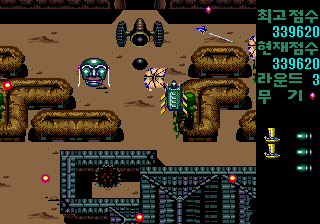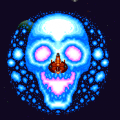It may sound surprising, but long, long before they’re testing the water with Nuon or VR accessories, Samsung Electronics already used to sell assorted gaming machines in South Korean market. In 1989, they signed a contract with Sega to import the Master System into their region, under rebranded trademark Samsung Gamboy, deliberately sidestepping the unconditional ban often put on the Japanese culture at that time. This deal soon proved to be a mega hit, which not only promoted the company to be one of the biggest publishers in the country, but encouraged them to expand the business, distributing all of Sega’s game machines until the Saturn era. In the meantime, Samsung’s ambition was further realized around in 1993, when Sega Genesis (sorry, “Super Aladdin Boy”) had already arrived there, as they announced to become the developer by themselves and ambitiously unveiled a shoot-em-up called Uju Geobukseon (“Space Turtle Ship”).
In the end, it appears Samsung didn’t have much faith in the plan, as Uju Geobukseon was the only thing coming out of this. The game has since been routinely derided in the coming years, often seen as a cheap cash-grab without any caring over its quality. That infamy isn’t entirely undeserved because, at a glance, Uju Geobukseon looks beyond appalling. The color is inexplicitly muddy, the art direction is nonexistent, and overall it hardly looks better than most of 8-bit shooters. All of this is accompanied by some of the lousiest soundtrack you’d ever hear on the Genesis, about half of which seems to be played off key. If it weren’t for Samsung logo on the title screen, anyone could’ve had hard time telling whether this game was a legitimate commercial release and not some bootleg cartridge nabbed from grey market.
Gameplay-wise, it generally fares better than what its look will make you think of, however damning with faint praise that is. You have two togglable weapons at the outset as well as smart bombs, though the latter isn’t nearly as helpful for crowd control due to their slow, clumsy reaction. Collect enough items obtained from certain enemies, and it’ll grant you a few useful upgrades such as shooting out more projectiles from your arsenal, making your ship slightly faster, or acquiring a stronger set of weaponry. This system also works as your health, as taking hits will cost you a downgrade, and eventually your life if none are left.
Uju Geobukseon is technically pretty short, clocking around 30 minutes to finish a total of 8 levels. Oddly enough, the first one takes place in Mesozoic era plateau and pits you against a herd of pterosaurs, an opening act that maybe fits better in The Magic School Bus. Unfortunately, the game doesn’t come up with much of anything to keep the levels visually attractive – the parallax scrolling in stage 2 is probably the most gorgeous thing it can show you – so you’d better get used to ugly browns and blues that plague the entire game. Regrettably, despite the classical Asian motif shown in the intro, that idea never truly comes into play. Only one level ever exploits it, which features castles and villages from Joseon dynasty. It doesn’t go well with the sci-fi setting, but at least it’s original. The rest of the game is spent in uninspired city warfare and space battle, with some bizarre objects like kites, giant swords, and bouncy balls (?) occasionally replacing the aircrafts.
There isn’t much else to say about the game without picking on its rudimentary design, but it does get profoundly strange near the end. The final level puts the player into what appears to be a motherboard of some machine, which then sends out an army of Samsung-labelled chipsets, trackball mice, and CRT monitors. This is a prelude to decisive battle against the super computer itself: an IBM-style desktop hardware on top of horizontal computer case. At least this marks one thing memorable about this game.
Below is extensive coverage from the May 1993 issue of Game Champ, which includes a short interview with Uju Geobukseon‘s programmer Lee Yongwook. Thanks to GameMeca for publishing the magazine online.
Q: Tell us about how Uju Geobukseon was created.
A: The game was initially planned back in May 1991, and the project was wrapped up last year on April. Due to some circumstances, we were able to ship the game only recently. There were four people to help this game see the light, including me as one of two programmers, with supports from a director and a graphic designer. […] Since this is the first 16-bit console game ever developed here, all of it had to be built from scratch entirely. We struggled on every aspect of programming, especially the graphics which we had no specialized tools to draw. It was an extraordinarily troublesome job to take.
Links:
Unseen64 – More info about cancelled City Heroes.


